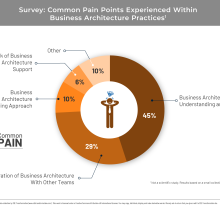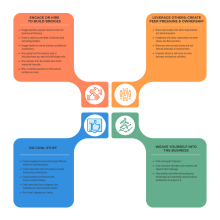Socializing business architecture and gaining buy-in for it within an organization is arguably the top challenge that business architecture teams have worldwide. The discipline has gained a lot of traction, especially from a business perspective, including the important role business architecture plays in enabling effective strategy execution. However, until business architecture reaches the tipping point of global adoption with executives, academia, and mainstream business literature, we are leading the charge one organization at a time. This means that if you are a business architecture leader, practitioner, or believer, you are also an agent of change – as many of you have discovered.
While there are no shortcuts or easy routes to the top of this mountain, this installment of StraightTalk provides you with loads of practical tips, secrets, and hacks for business architecture socialization based on the collective wisdom of business architecture practitioners around the world.
So, I’m not the only one experiencing challenges with gaining understanding and buy-in for business architecture in my organization?
Not at all. The first thing for you to know is that you’re not crazy and you’re not alone.
The numbers tell us the same thing. For example, a recent survey of global business architecture practitioners reflects Business Architecture Understanding and Buy-In as the top challenge (45% of respondents) followed by Integration of Business Architecture With Other Teams (29% of respondents), which is often related to the understanding and buy-in of those teams.
However, there is momentum and promise. Another recent survey of attendees at the Guild Business Architecture Innovation Summit in September 2020 indicated that 51% of respondents expect business architecture adoption by a solid majority of people within their organizations to occur within the next 5 years or less, with a total of 87% expecting it in up to 10 years.
Where do we start?
Before the secrets of socialization will work, first and foremost, you must define a clear, simple, relevant, and consistent value proposition for business architecture in your organization. This is the foundation of it all and the key to a successful business architecture practice.
In addition, keep in mind some of the key themes you’ve learned throughout StraightTalk:
- Lead with value and build as you go – Once you have your business architecture baseline in place (value streams, capabilities, and cross-mapping), build the rest of the business architecture just enough just in time to support your business usage scenarios.
- Build partnerships – Business architecture and business architects must work effectively within the bigger context of other teams, processes (e.g., strategy execution), and frameworks (e.g., SAFe).
- Position business architecture as business-focused and strategic – Position business architecture as a bridge between strategy and execution upfront from initiatives.
- Focus on the business in business architecture – Shift your mindset and actions to focus on business goals, opportunities, and challenges – business architecture will just help you to frame, analyze, and communicate about them.
- Show up with WOW – It’s not just about what we do, but also about how we work and interact with others. (See more about business architecture Ways of Working in Post No. 64.)
Got it. What are some tips for socializing business architecture then?
Here are some of the best practical secrets and hacks to build business architecture buy-in within an organization over time. Leverage the tips that are applicable to your situation and let the rest inspire your own ideas.
- Engage or hire to build bridges – Be intentional about who you hire to build bridges and address any gaps you have on the team or within your practice. For example,
- Engage business people to build and own the business architecture. (You should always do this anyway.)
- Create a steering committee of business (and technology) leaders to guide your direction and help advocate for business architecture.
- Engage leaders to mentor business architecture practitioners. They will inevitably have a stake in your success.
- Hire people from the business area, discipline, or team you need to build bridges with.
- Hire someone from the outside who will be respected internally.
- Offer a rotational position on the business architecture team. This not only helps you gain exposure, but also gives these individuals a new understanding and stake in business architecture success.
- Leverage others and create peer pressure and ownership – Leverage advocates and successes within or outside of your organization to help build buy-in and even create some peer pressure. Engage others so they have a stake in the future. For example:
- Share business architecture case studies and success stories from other organizations and leverage external experts.
- Collaborate with other organizations to share stories and best practices. The exchange can be a one-time event or a formalized, ongoing relationship (e.g., a roundtable involving multiple companies).
- Share your own success stories within the organization and ask internal advocates to endorse them and share a quote of support.
- Empower others to self-serve on some business architecture activities.
- Do cool stuff – It may sound shallow, but engaging and polished visuals, designs, and tools matter. Get peoples’ attention and respect so that you can share your important value and messaging. For example:
- Create engaging visuals and leverage different media for communications (e.g., videos and animations).
- Create interactive tools for people to access the business architecture (e.g., interactive maps with connections to other things such as initiatives or applications).
- Couple business architecture with human-centered design to present it within a more customer-focused and business-friendly format.
- Enlist some help from colleagues with marketing or communication talents.
- Be a visual, engaging co-creator. As mentioned above, it’s not just about what you do, but also how you show up.
- Weave yourself into the business – Immerse in the business from every angle. Remember that you and your leaders and advocates do not necessarily need to have an official business architecture role to make a significant impact. For example, when a key supporter moves into a new role, don’t be disheartened, but rather celebrate that you’ll have an advocate within another part of the organization. Or, if you yourself move into another business role, then leverage business architecture as part of your job. For example:
- Learn executive strengths and concerns and speak in their language.
- Think and speak “business.” Learn the language and mindset.
- Take another role within the business (or technology) and seamlessly weave business architecture in as part of it.
Check out the handy diagram below for a summary of these key points.
Anything else?
Until the day when business architecture is fully adopted worldwide, just remember…
“All truth passes through three stages: First, it is ridiculed. Second, it is violently opposed. Third, it is accepted as self-evident.”
– Arthur Schopenhauer
Keep on keeping on. What you do makes a difference every single day.
More Good Stuff...
StraightTalk Posts: Here are some throwbacks relevant to the topic of business architecture socialization and buy-in: Posts No. 34 on Business Marketecture and No. 38 on Business Politecture, Post No. 72 on The Secret of business architecture, The Seeing Is Believing Mini-Series on Visualization and Storytelling, and Post No. 4 on how to build a business architecture practice by leading with value and building as you go.
Visualizing Business Transformation: Pictures, Diagrams and the Pursuit of Shared Meaning (book by Jonathan Whelan and Stephen Whitla): The book is a great read and below are two related articles. These articles are must-reads for business architects because they guide how we think about visualizations and communication with others on architecture-related topics.
- What is Shared Meaning and Why Does It Matter? (Steve Whitla): Here’s an excellent article on shared context. You’ll find the relevance to architecture immediately.
- Visualizing Business Transformation: The Pursuit of Shared Meaning (Steve Whitla): Another excellent one that guides you on choosing the right visual and communication approach for different audiences.
Make Your Company’s Culture Go Viral (Strategy+Business): How to spread the critical behaviors that drive strategy forward.
Rules of Thumb for Change Agents (Herb Shepard): Still relevant and insightful.
Complex Contagion (Wikiwand): Complex contagion is the phenomenon in social networks in which multiple sources of exposure to an innovation are required before an individual adopts the change of behavior. There are some relevant considerations for socialization here.
Embracing Change (TED Talk): If you are a change leader for business architecture (or anything else), this TED Talk by Jason Clarke is a must-watch. He lays out the seven reasons why people resist change and what to do about them. Seriously, you will relate to it and take away some new ideas that you can use.



